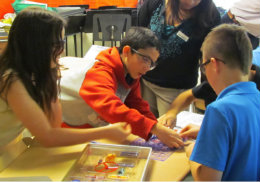Teaching STEM This Fall? Here Are Some Things To Do in July

Since STEM is a relatively new initiative, summer is the ideal time to think through some ways to ratchet up your success in the coming school year. And if you’re a new STEM teacher, this is a perfect time to dive in and wrap your head around what you’ll be doing so you’ll get off to a great STEM start.
Here are some of my suggestions for what you could be doing in July to prepare for the beginning of school in August or September.
Start with focused learning

List your ideas as they emerge. For example, you may be wondering how you can provide explicit support to help kids understand and apply key concepts in science and math at deeper levels. Or how could you blend digital technology into your STEM classes in a more significant way.
Perhaps productive student teamwork is something you want to know more about. (If that’s the case, click here and put “Student Teamwork” in the subject line – I’ll send you some tips.) Or how might you design your STEM lessons to tap into student’s passions.
Remember – you don’t have to tackle everything on your list at once. Just choose one and get started.
Build up a collection of STEM wisdom
Spend some time this July exploring STEM online resources. This activity will keep STEM on your front burner as well as build your enthusiasm and generate new ideas for your classroom.

In case you want to take a look at other available curation tools, here’s a link that features a long list. If you have a favorite site where you save and curate materials, please share it in the response column at the end of this post. (Anybody use Pinterest for this? Diigo?)
Another way to stay abreast of the latest articles, blogs, and activities that involve STEM is by subscribing to some SmartBriefs – free, attractive, news summaries. Warning: you may have to scroll down a list of other worthwhile education articles to find those dealing with STEM, but that’s interesting, too.
I subscribe to MiddleWeb SmartBrief, STEM Smartbrief, ASCD SmartBrief, SmartBrief on EdTech, and Accomplished Teacher SmartBrief (NBCT), and my list is growing. It takes me about 30 seconds to scroll down and locate any material I want to read. I also recommend the websites Edutopia and MindShift for spotting good, informative reads on STEM-related subjects.
Connect with STEM colleagues
July is also a great time to put together a learning and support network for teaching STEM. You likely already have an online network composed of friends on a number of social media sites. You may have even intentionally networked with colleagues to explore STEM topics and resources. If that’s the case, you have already established a personal learning network (PLN) – a community of friends and followers who share your STEM interests. This is a powerful STEM professional learning and support tool.

Many teachers and school leaders rely on Twitter’s hashtag communities to help build their online personal learning networks. Debra Shapiro, Associate Editor at NSTA Reports, shared the following Twitter hashtags with us — follow them in your Twitter aggregator (like TweetDeck) to spot lots of helpful STEM information: #nsta (you can also access this here) plus #scichat, #scienceed, #edtech, #stem, and #scied. You might also follow @StemEdCoalition, @TeachingSTEM and@STEMAhead. I also keep up with #STEMchat and #stemed.
Reaching out to colleagues

Ideally you want to include science, math and technology teachers. STEM involves coordinating and integrating those subjects, and all teachers should be involved in planning STEM lessons, even if all do not officially teach STEM classes.
You can also form a professional learning team with STEM teachers from other schools. This team may meet less frequently and may sometimes meet through virtual mediums such as Google Hangouts or Skype, but the payoff can be high. You might spend some time in July considering how to set up some of these support systems. (Tip: one good way to stay in touch – your own twitter hashtag for your formal or informal STEM PLT. Twitter doesn’t register them – you just make one up and start using it (e.g., #stemplt).
Plan for STEM lessons

Notice that the post also offers several online locations where you can find STEM lessons, as well as other links on this blog that can guide you in developing STEM lessons.

In the event that you’re thinking of simply chilling out during July, please do that as well! But consider . . . a few STEM minutes at summer’s peak might make a big difference for you and your students when the leaves turn bright fall colors and the ghosts and goblins reappear!


































Anne,
I would like to integrate STEM into more of my social studies World Geography class curriculum, but there isn’t a big movement in that direction even though everyone can see the connection. Since geography is science based and there are so many careers that are open in the fields, I feel somewhat responsible to start some program locally.
Great information.